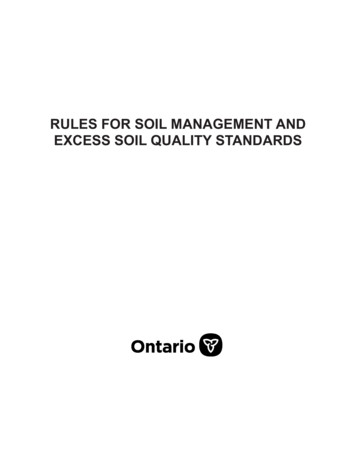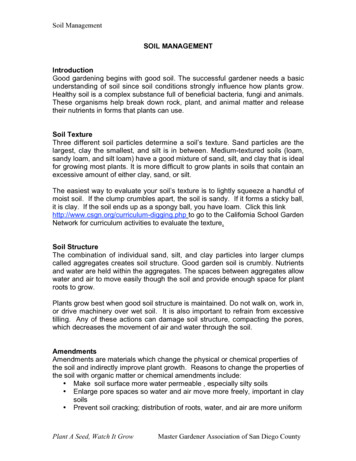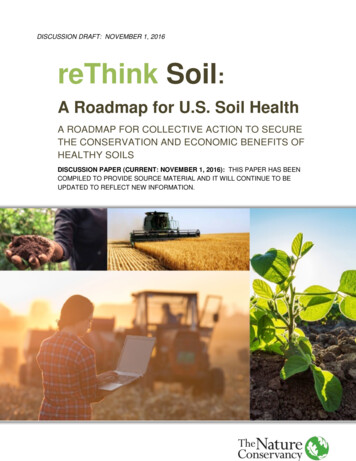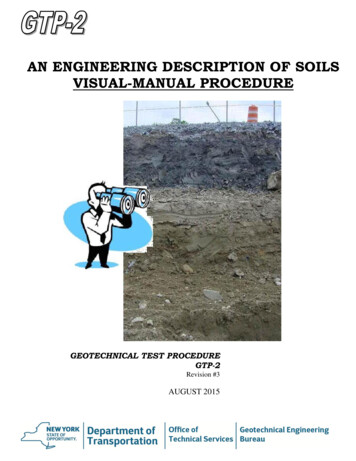
Transcription
RULES FOR SOIL MANAGEMENT ANDEXCESS SOIL QUALITY STANDARDS
Queen’s Printer for Ontario, 2020Ontario Ministry of Environment, Conservation and ParksISBN 978-1-4868-3709-0
RULES FOR SOIL MANAGEMENT AND EXCESS SOIL QUALITY STANDARDSThis document, “Rules for Soil Management and Excess Soil Quality Standards”, isadopted by reference in O. Reg. 406/19 (On-Site and Excess Soil Management) madeunder the Environmental Protection Act, R.S.O. 1990, c. E.19 (EPA).CONTENTSINTRODUCTION.1PART I: RULES FOR SOIL MANAGEMENT.3SECTION A INTERPRETATION.4SECTION B EXCESS SOIL REUSE PLANNING.91.ASSESSMENT OF PAST USES.92.SAMPLING AND ANALYSIS PLAN.163.SOIL CHARACTERIZATION REPORT.234.EXCESS SOIL DESTINATION ASSESSMENT REPORT.265.TRACKING SYSTEM.286.QUALIFIED PERSON DECLARATION.29SECTION C SOIL MANAGEMENT REQUIREMENTS.301.SOIL STORAGE RULES.302.ADDITIONAL RULES FOR CLASS 2 SOIL MANAGEMENT SITES AND LOCALWASTE TRANSFER FACILITIES.313.ADDITIONAL RULES FOR RESIDENTIAL DEVELOPMENT SOIL DEPOTS.324.ADDITIONAL RULES FOR RETAIL LANDSCAPING SOIL DEPOTS.335.REQUIREMENTS FOR MIXING FOR THE PURPOSE OF DEWATERING ORSOLIDIFYING LIQUID SOILS.34SECTION D REUSE RULES FOR SPECIFIC CIRCUMSTANCES.361.RULES FOR SPECIFIC TYPES OF SOIL.362.RULES FOR SPECIFIC TYPES OF REUSE SITES.383.BENEFICIAL REUSE ASSESSMENT TOOL (BRAT).394.RISK ASSESSMENT.41PART II: EXCESS SOIL QUALITY STANDARDS.43SECTION A DETERMINING APPLICABLE GENERIC EXCESS SOIL QUALITYSTANDARDS.441.RULES ASSOCIATED WITH THE USE OF EXCESS SOIL QUALITY STANDARDS.46APPENDIX 1. GENERIC EXCESS SOIL QUALITY STANDARDS.52APPENDIX 2. GENERIC LEACHATE SCREENING LEVELS FOR EXCESS SOIL REUSE.94APPENDIX 3. CEILING VALUES FOR EXCESS SOIL REUSE.132iii
INTRODUCTIONThis document, titled “Rules for Soil Management and Excess Soil Quality Standards”(this document), is adopted by reference in O. Reg. 406/19 (On-Site and Excess SoilManagement) made under the Environmental Protection Act, R.S.O. 1990, c. E.19 (EPA)(the regulation).There are two distinct parts to this document.Part I of this document is entitled “Rules for Soil Management” (Soil Rules). Where aprovision of the regulation requires compliance with the “Soil Rules” that provision isreferring to Part I of this document.Part I of this document, “Soil Rules”, is subject in the regulation to a rolling incorporation.The Soil Rules may be updated from time to time without the need to amend theregulation.Part II of this document is entitled “Excess Soil Quality Standards” (Excess SoilStandards). Where a provision of the regulation requires compliance with the “ExcessSoil Standards”, that provision is referring to Part II of this document.Part II of this document, the “Excess Soil Standards”, is subject in the regulation to astatic incorporation. The Excess Soil Standards can only be changed by amending theregulation to refer to an updated version of the Excess Soil Standards.Notice of revisions to this document will be posted on the Environmental Registry ofOntario (ERO).Beyond this document, additional guidance in relation to the management of excess soilmay be available on the website of the Ministry of the Environment, Conservation andParks.Note: for excess soil movements to Record of Site Condition (RSC) properties, pleasealso refer to requirements for excess soil being brought to an RSC property in O. Reg.153/04.1
PART I: RULES FOR SOIL MANAGEMENTSECTION A: Interpretation, defines key terms. Some of these definitions arereproduced from the Act or regulation indicated, and in the event that any of thesedefinitions are amended in the source Act or regulation, the definition in the source Actor regulation prevails.SECTION B: Excess Soil Reuse Planning, provides excess soil planning andmanagement requirements as provided for by the regulation, including an assessmentof past uses, a sampling and analysis plan, a soil characterization report, an excess soildestination assessment report and requirements of a tracking system.SECTION C: Soil Management Requirements, provides requirements associated withsoil management, including those applicable to soil processing and soil storage relatedto the project area, Class 2 soil management sites, local waste transfer facilities andreuse sites, as applicable.SECTION D: Reuse Rules for Specific Circumstances, provide requirementsassociated with specific rules for reuse sites including rules for specific types of soil,types of reuse sites, use of the Beneficial Reuse Assessment Tool (BRAT) and riskassessments (RA).PART II: EXCESS SOIL QUALITY STANDARDSSECTION A: Determining Applicable Generic Excess Soil Quality Standards,provides direction on determining the applicable generic excess soil quality standards ata reuse site.APPENDIX 1: Generic Excess Soil Quality StandardsAPPENDIX 2: Generic Leachate Screening Levels for Excess Soil ReuseAPPENDIX 3: Ceiling Values for Excess Soil Reuse2
PART I: RULES FOR SOIL MANAGEMENT8 DECEMBER 20203
SECTION AINTERPRETATION1.(1)In this document,“area of potential environmental concern” or “APEC” means the area on, in or under aproject area where one or more contaminants are potentially present, as determinedthrough an assessment of past uses, including through,a) identification of one or more potentially contaminating activities;b) identification of one or more potentially contaminating activities;“assessment of past uses study area” means the area that includes:1.the project area;2.any other property that is located, wholly or partly, within 250 metres from thenearest point on a boundary of the project area; and3.any property that the qualified person determines should be included as a partof the assessment of past uses study area that is not located, wholly or partly,within 250 metres from the nearest point on a boundary of the project area;“building” has the same meaning as in the Building Code Act, 1992, S.O. 1992, c. 23;“Beneficial Reuse Assessment Tool” or “BRAT” and has the same meaning as in theregulation;“ceiling values” means values listed in the tables of Ceiling Values, within Part II –Excess Soil Quality Standards, contained in Appendix 3 of this document;“Class 1 soil management site” has the same meaning as in the regulation;“Class 2 soil management site” has the same meaning as in the regulation;“contaminant of concern” means one or more contaminants found on, in or under aproject area at a concentration that exceeds the applicable excess soil quality standardsfor the project area;“contaminant of potential concern” or “COPC” includes a contaminant identified aspotentially present on, in or under a project area in an assessment of past uses;“crushed rock” has the same meaning as in the regulation.4
“environmentally sensitive area” means any of the following:1.An area reserved or set apart as a provincial park or conservation reserveunder the Provincial Parks and Conservation Reserves Act, 2006, S.O. 2006,c. 12.2.An area of natural and scientific interest (life science or earth science)identified by the Ministry of Natural Resources and Forestry as havingprovincial significance.3.A wetland or a coastal wetland identified by the Ministry of Natural Resourcesand Forestry as having provincial significance, or a wetland or coastal wetlandthat is not yet evaluated to determine whether it is provincially significant.4.A significant woodland identified by a municipality in accordance with theProvincial Policy Statement under the Planning Act, R.S.O. 1990, c. P.13.5.An area designated by a municipality in its official plan as environmentallysignificant, however expressed, including designations of areas asenvironmentally sensitive, as being of environmental concern and as beingecologically significant.6.An area designated as an escarpment natural area or an escarpmentprotection area by the Niagara Escarpment Plan under the NiagaraEscarpment Planning and Development Act, R.S.O. 1990, c. N.2.7.An area identified by the Ministry of the Environment, Conservation and Parksas significant habitat of a threatened or endangered species.8.An area which is habitat of a species that is classified under section 7 of theEndangered Species Act, 2007, S.O. 2007, c. 6 as a threatened or endangeredspecies.9.A property within an area designated as a natural core area or natural linkagearea within the area to which the Oak Ridges Moraine Conservation Planunder the Oak Ridges Moraine Conservation Act, 2001, S.O. 2001, c. 31applies.10. An area set apart as a wilderness area under the Wilderness Areas Act, R.S.O.c. W.8;“EPA” means the Environmental Protection Act, R.S.O. 1990, c. E.19;“excess soil” has the same meaning as in the regulation;5
“generic excess soil quality standards” means the following standards as described orprovided in Part II Excess Soil Quality Standards:a)b)c)Table 1 “Full Depth Background Site Condition Standards”;Tables for the “small volume excess soil quality standards” andTables for the “volume independent excess soil quality standards”;“infrastructure” means all physical structures, facilities and corridors relating to:a)b)c)d)e)f)g)h)i)public highways;transit lines and railways;gas and oil pipelines;sewage collection systems and water distribution systems;stormwater management systems;electricity transmission and distribution systems;telecommunications lines and facilities, including broadcasting towers;bridges, interchanges, stations and other structures, above and below ground,that are required for the construction, operation or use of the items listed inclauses (a) to (g); orrights of way required in respect of existing or proposed infrastructure listed inclauses (a) to (h);“leachate screening levels” means values that are listed in the tables of LeachateScreening Levels within Part II – Excess Soil Quality Standards, contained in Appendix2 of this document;“local waste transfer facility” has the same meaning as in the regulation;“ministry” means the Ontario Ministry of the Environment, Conservation and Parks;“O. Reg. 153/04” means Ontario Regulation 153/04 (Records of Site Condition – PartXV.1 of the Act) made under the EPA;“potentially contaminating activity” or “PCA” is any activity listed in Table 2 to ScheduleD of O. Reg. 153/04;“project” has the same meaning as in the regulation;“project area” has the same meaning as in the regulation;“project leader” has the same meaning as in the regulation;“public body” has the same meaning as in the regulation;“qualified person” has the same meaning as in the regulation;6
“rationale document” means the Rationale Document for Development of Excess SoilQuality Standards as developed by the ministry;“retail landscaping soil depot” has the same meaning as in the regulation;“reuse site” has the same meaning as in the regulation;“the regulation” means the On-Site and Excess Soil Management regulation madeunder the EPA;“residential development soil depot” has the same meaning as in the regulation;“sampling location” means an area of the property that does not have a radius largerthan two metres, as defined in subsection 48 (4) of O. Reg. 153/04;“site-specific instrument” means one of the following instruments:1.A permit that is issued under a by-law passed under section 142 of theMunicipal Act, 2001 or section 105 of the City of Toronto Act, 2006.2.Provisions of a by-law passed under section 142 of the Municipal Act, 2001 orsection 105 of the City of Toronto Act, 2006.3.A licence or permit issued under the Aggregate Resources Act.4.An approval under the Planning Act.5.A certificate of property use issued under section 168.6 of the EPA.6.Any other site-specific instrument under an Act of Ontario or Canada that mayregulate the quality or quantity of soil that may be deposited for final placementat the reuse site.“small volume excess soil quality standards” are the same as the Soil, Ground Waterand Sediment Standards for coarse textured soil (Tables 2 to 9) set out in O. Reg.153/04;“soil” has the same meaning as in the regulation;“soil bank storage site” has the same meaning as in the regulation;“soil processing site” has the same meaning as in the regulation;“Soil, Ground Water and Sediment Standards” has the same meaning as in O. Reg.153/04;“subsurface soil” has the same meaning as in O. Reg. 153/04;7
“supervisee” has the same meaning as in the regulation;“surface soil” has the same meaning as in O. Reg. 153/04;“topsoil” has the same meaning as in the Municipal Act, 2001, S.O. 2001, c. 25;“volume independent excess soil quality standards” means excess soil quality standardsincluded in this document (Table 1 and Table 2.1 to 9.1, inclusive, within Part II – ExcessSoil Quality Standards, as included in Appendix 1 of this document) and includesleachate screening levels (Appendix 2 of this document);“water body” has the same meaning as in O. Reg. 153/04;The following types of property uses have the same meaning as in O. Reg. 153/04:1.Agricultural or other use;2.Commercial use;3.Community use;4.Industrial use;5.Institutional use;6.Parkland use; and7.Residential use.8
SECTION BEXCESS SOIL REUSE PLANNINGSections 8 to 16 of the regulation require a project leader for a project to complywith specific requirements before removing excess soil from a project area. Theseobligations apply to the projects and in the circumstances set out in the regulation.Generally, the requirements include the following:1.2.3.4.5.Preparation of an assessment of past uses;Preparation and implementation of a sampling and analysis plan;Preparation of a soil characterization report;Preparation of an excess soil destination assessment report; andDevelopment and implementation of a tracking system.The regulation provides that each of these steps be undertaken in accordance withthe Soil Rules. Steps 1-4 must be conducted or supervised by the source site qualifiedperson, step 5 can be undertaken or overseen by the source site project leader. Thissection sets out the requirements for each of these steps.1.ASSESSMENT OF PAST USES(1) This section contains the requirement for the preparation of an assessment of pastuses for the purposes of subsection 11 (1) of the regulation.1.Sections 27 and 29 of O. Reg. 153/04 apply with necessary modifications tothe preparation of an assessment of past uses.(2) The assessment of past uses must achieve the following general objectives:1.To develop a preliminary determination of the likelihood that one or morecontaminants have affected soil or rock in a location where soil or crushed rockis to be excavated within the project area.2.To identify any areas of potential environmental concern (APECs) within theproject area and to determine if any location where soil or crushed rock is tobe excavated could have been affected by a potentially contaminating activity(PCA).3.To identify the contaminants of potential concern (COPCs) to determine thefocus of the sampling and analysis plan, if any areas of potential environmentalconcern (APECs) are identified.(3) The assessment of past uses must contain the following components:1.A records review;9
2.Interviews, unless the qualified person determines that carrying out theinterview component is not necessary, having regard to the general objectivesof the assessment of past uses;3.Site reconnaissance;4.A review and evaluation of the information gathered from the records review,interviews and site reconnaissance including the preparation of a conceptualsite model; and5.The preparation of an assessment of past uses report.(4) Each of the components of the assessment of past uses must achieve thespecific objectives and each must comply with the requirements specified insubsections (5)-(9).(5) Records review1.The specific objective of the records review is to obtain and review records thatrelate to the assessment of past uses study area, including both the currentand past uses of the project area and the potentially contaminating activities(PCAs) at or affecting the project area, in order to determine if an area ofpotential environmental concern (APEC) exists within the project area wheresoil or crushed rock will be excavated.2.The records review component must comply, with necessary modifications,with all of the requirements in section 3 of Schedule D to O. Reg. 153/04,unless the qualified person, having regard to the specific objective of thiscomponent and the general objectives of the assessment of past uses, isof the opinion that it is not necessary to comply with one or more of theserequirements.(6) Interviews1.The specific objectives of the interview component of the assessment of pastuses are to:i.obtain information to assist in determining if an area of potentialenvironmental concern (APEC) exists within the project area where soil orcrushed rock will be excavated; andii. identify details of potentially contaminating activities (PCAs) or potentialcontaminant pathways that could result in the presence of contaminants insoil or crushed rock that is to be excavated within the project area.10
2.Except in circumstances where the qualified person is of the opinion, havingregard to the general objectives of the assessment of past uses, that it is notnecessary to complete the interviews component, the interviews componentmust comply, with necessary modifications, with all the requirements insections 5 to 8 of Schedule D of O. Reg. 153/04.(7) Site reconnaissance1.The specific objectives of the site reconnaissance component of theassessment of past uses are to:i.determine if any areas of potential environmental concern (APECs) existwithin the project area where soil will be excavated, through observationsabout current and past uses and potentially contaminating activities(PCAs) in the assessment of past uses study area.ii. identify details of:a) Potential contaminant pathways that could result in the presence ofcontaminants in soil to be excavated within the project area; andb) Every area of potential environmental concern (APEC) and thecontaminant of potential concern (COPC) within the project areawhere soil will be excavated.2.The site reconnaissance component must comply, with necessarymodifications, with all of the requirements in sections 10 to 15 of Schedule Dof O. Reg. 153/04, unless the qualified person is of the opinion, having regardto the specific objectives of this component and the general objectives of theassessment of past uses, that it is not necessary to comply with one or more ofthese requirements.(8) Review and evaluation of the information gathered from the records review,interviews and site reconnaissance:1.The review and evaluation component must comply, with necessarymodifications, with subsections (1) to (6) of section 16 of Schedule D to O.Reg. 153/04. The component must also include the preparation of a conceptualsite model.2.The conceptual site model shall consist of figures and narrative descriptionsand assessments as set out below:i.Provide one or more figures of the assessment of past uses study areathat:a) show any existing buildings and structures in the project area;b) show roads, including names, within the assessment of past usesstudy area;11
c)ii.show uses of properties adjacent to the project area (where theexamination of the assessment of past uses study area is necessary);d) identify and locate areas where any potentially contaminating activity(PCA) is occurring or has occurred within the assessment of pastuses study area, and show tanks within such areas; ande) identify and locate any areas of potential environmental concern(APECs) within the project area that could results in the presence ofcontaminants in soil or crushed rock that is to be excavated within theproject area.Provide a description and assessment of:a) any areas where any potentially contaminating activity (PCA) on orpotentially affecting the project area has occurred;b) any contaminants of potential concern;c) available regional or site-specific geological and hydrogeologicalinformation; andd) how any uncertainty or absence of information obtained in each of thecomponents of the assessment of past uses could affect the validity ofthe model.(9) The assessment of past uses report shall include:1.Persons involved in the project:i.project leader(s): The name, mailing address, e-mail address, andtelephone number of all project leader(s) for the project; andii. qualified person(s): The name, mailing address, e-mail address, telephonenumber, and type of licence(s) held for any qualified person(s) whoconducted or supervised the assessment of past uses.2.Description of the project and project area:i.a general description of the project and project type; andii. if the project involves a change of property use in the project area,describe the change.3.A general description of the project area including:i.any municipal address(es) and property identification number(s) applicableto the property or properties comprising the project area;ii. a list of the owner(s) of the property or properties comprising the project area;iii. a map of the project area showing the boundaries of the project areaand of the property or properties comprising the project area; structuralfeatures including buildings, paved surfaces, natural features, and areasof planned excavation, stockpiling, and processing of soil that may beremoved from the project area; geographic coordinates of the approximatecentre of the project area projected on the UTM grid coordinate systemidentifying easting, northing and zone based on NAD 83 datum;12
iv.v.a list of any legal instruments that apply to soil management within theproject area (e.g., Environmental Compliance Approval, by-law or permitissued under a by-law passed under section 142 of the Municipal Act,2001, or section 105 of the City of Toronto Act, 2006); anda statement as to whether a record of site condition has been filed to theEnvironmental Site Registry, or is intended to be submitted for filing underPart XV.1 of the EPA for all or part of the project area, and whether a riskassessment has been or will be submitted to the Director under Part XV.1of the EPA.4.If the qualified person is of the opinion that it was not necessary, in preparingthe assessment of past uses, to comply with the applicable requirements ofSchedule D to O. Reg. 153/04, the qualified person or supervisee must, in thereport:i.identify every applicable requirement of Schedule D to O. Reg. 153/04 thatwas not complied with;ii. describe the rationale for the opinion;iii. identify and describe any information gaps in that component as a result ofthe non-compliance; andiv. describe how the information gaps shall be addressed in the preparationof the sampling and analysis plan to ensure that the general objectives ofthe excess soil characterization can be satisfied.5.A table, prepared by the qualified person or supervisee, that sets out:i.every area of potential environmental concern (APEC) within the projectarea that could result in the presence of contaminants in the soil to beexcavated (i.e., the table of areas of potential environmental concern(APECs) specified in section 16 (2) (a) of Schedule D of O. Reg. 153/04);andii. current and past uses of the project area, to the extent past uses havebeen investigated as part of the assessment of past uses (i.e. the table ofcurrent and past uses specified in section 16 (2) (b) of Schedule D of O.Reg. 153/04).6.The conceptual site model that was prepared as part of the reviewof information gathered from the records review, interviews and sitereconnaissance component.7.The qualified person’s conclusions, based on a review of the informationcollected during the assessment of past uses and on the exercise ofprofessional judgment, about the following:i.the existence and location of any areas of potential environmental concern(APECs) within the project area that could result in the presence ofcontaminants in soil that is to be excavated within the project area;13
ii.iii.iv.the current and past uses of the project area;the likelihood that one or more contaminants have affected the soil orcrushed rock that is to be excavated within the project area; andthe contaminants of potential concern (COPCs) that shall be the focus ofthe sampling and analysis plan.8.Provide original signatures of the qualified person who conducted orsupervised the assessment of past uses.9.Provide a statement by the qualified person confirming the carrying out of theassessment of past uses and the findings and conclusions of the report.(10) Use of Assessments and Existing Reports1.A report that has been prepared to determine the likelihood that contaminantsaffected the soil or crushed rock within a project area that may become excesssoil, including a report that updates a previous report, may be used by aqualified person as an assessment of past uses report for a project if,i.the date the last work was done on all of the records review, interviewsand site reconnaissance required for the assessment of past uses thatis the subject of the report is no later than 18 months before the filing anotice in the Registry for the project or the commencement of work on thedevelopment of a sampling and analysis plan;ii. in the professional opinion of the qualified person, there is no new ormaterially changed area of potential environmental concern at the projectarea that has arisen since the date of the last work for the assessment ofpast uses that is the subject of the report;iii. the assessment of past uses meets the requirements for an assessmentof past uses report;iv. the report is a single document; andv. the report is the most recent document that meets these requirements forthe project area.2.If paragraph 1 does not apply to a report or an updated report mentioned inthat subsection, the qualified person or supervisee shall, before filing a noticein the Registry for the project or commencing work on the development of asampling and analysis plan, update the report by conducting or supervisingsuch further components of an assessment of past uses as may be necessaryto satisfy the requirements of all the components of an assessment past usesand to achieve both the general and specific objectives of an assessment ofpast uses.14
3.The requirements in paragraphs 1 and 2 in respect of the requirements to besatisfied when relying on an existing report or assessments of the project areado not apply to an assessment undertaken before January 1, 2022, as theassessment is deemed to satisfy the requirements of an assessment of pastuses under subsection 11 (3) of the regulation.NOTE: For the purposes of the sub-section governing the preparation of theassessment report, where a provision of this sub-section requires compliance with aprovision of O. Reg. 153/04 with necessary modifications, a reference in O. Reg. 153/04 to a “phase one environmental site assessment”is deemed to be a reference to an “assessment of past uses”; a reference in O. Reg. 153/04 to a “phase one property” is deemed to be areference to a “project area”; a reference in O. Reg. 153/04 to a “phase one study area” is deemed to be areference to an “assessment of past uses study area”; and a reference in O. Reg. 153/04 to an “enhanced investigation property” isdeemed to be a reference to an “enhanced investigation project area”.15
2.SAMPLING AND ANALYSIS PLANFor the purposes of subsection 12 (1) of the regulation, where a sampling and analysisplan is required, it shall meet the requirements outlined in this section.(1) The sampling and analysis plan shall be prepared to achieve the followinggeneral objectives:1.Identify each location where soil or crushed rock is to be excavated as definedby the area of potential environmental concern (APEC) that will be subject tosampling and analysis, based on the assessment of past uses.2.Ensure an appropriate level of sampling and analysis is carried out todetermine the concentration of contaminants in the excavated soil or crushedrock to identify:i.which soil or crushed rock may be reused within the project area, withor without processing at the project area, and which excess soil may bedeposited at a Class 1 soil management site or at a landfill or dump; andii. the potential reu
Beyond this document, additional guidance in relation to the management of . excess soil. may be available on the website of the Ministry of the Environment, Conservation and Parks. Note: for . excess soil. movements to Record of Site Condition (RSC) properties, please also refer to requirements for . excess soil. being brought to an RSC .











